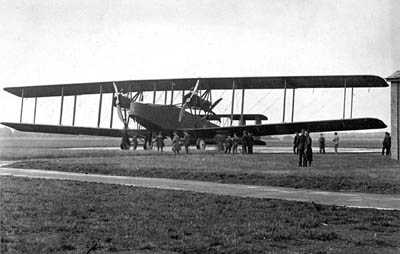- Handley Page V/1500
infobox Aircraft
name = Handley Page V/1500
type = Heavy Bomber
manufacturer =Handley Page 
caption =
designer =George Rudolph Volkert
first flight =22 May 1918
introduction = 1918
retired =
status =
primary user =Royal Air Force
more users =
produced =
number built = 63
unit cost =
developed from =
variants with their own articles =TheHandley Page V/1500 was an uprated design from the O/400 with the intention of bombingBerlin fromEast Anglia n airfields. It was colloquially known within the fledglingRoyal Air Force as the "Super Handley".The V/1500 used four
Rolls-Royce Eagle VIII engines mounted in two nacelles, so two engines were pulling in the conventional manner and two pushing. A forward-looking design feature was the gunner's position at the extreme rear of the fuselage, between the four fins.ervice
Three aircraft were delivered to No. 166 Squadron at
RAF Bircham Newton (Norfolk ) during October 1918. The squadron commander did not get clear orders for his mission untilNovember 8 due to debate at high level. A mission was scheduled for that night (bomb Berlin, fly on toPrague as the Austro-Hungarian forces had surrendered by then, refuel, re-arm, bombDüsseldorf on the way back). No mission was flown - a technical expert insisted that all the engines on one aircraft be changed. The same happened the following day (but with a different aircraft). The three aircraft were about to taxi out after the second set of engine changes when an excited ground crew member ran out to stop them — theArmistice had just been declared.One of the original batch of aircraft (J1936, "Old Carthusian") went on to record two significant 'firsts'. On
13 December 1918 the bomber, flown by MajorA.C.S. Maclaren and CaptainRobert Halley , accompanied byBrigadier-General N.D.K. McEwan , made the first ever 'through-flight' fromEngland toIndia . Taking off from Britain the aircraft flew viaRome ,Malta ,Cairo , andBaghdad , finally reachingKarachi on30 December .The same aircraft played a pivotal role in ending the
Third Anglo-Afghan War . On24 May 1919 , flying fromRisalpur piloted by Captain Robert "Jock" Halley and with LtE. Villiers as observer, the V/1500 reachedKabul in three hours. Of its payload of eight 112-lb bombs and 26 20-lb bombs, four bombs hit the royal palace. Although the bombing did little physical damage, it had a great psychological impact on the citizens — the ladies of the royalharem rushed onto the streets in terror, causing great scandal. A few days later King Amanullah sued for peace, bringing an end to the war after less than one month of hostilities. This could be said to be the first decisive use ofstrategic bombing .Fact|date=April 2008.Final production of the V/1500 totalled 60 aircraft. They were eventually replaced in service by the
Vickers Vimy . J1936 ended its life being consumed bytermite s.Operators
; UK
*Royal Air Force
**No. 166 Squadron RAF
**No. 167 Squadron RAF
**No. 274 Squadron RAF pecifications (V/1500)
aircraft specifications
plane or copter?=plane
jet or prop?=prop
ref=
crew=7
capacity=
payload main=
payload alt=
length main= 64 ft 9 in
length alt=19.74 m
span main=126 ft
span alt=38.40 m
height main=23 ft
height alt=7.01 m
area main= 3,000 ft²
area alt= 278.7 m²
airfoil=
empty weight main= 17,600 lb
empty weight alt= 7,983 kg
loaded weight main=
loaded weight alt=
useful load main=
useful load alt=
max takeoff weight main= 30,000 lb
max takeoff weight alt= 13,608 kg
more general=engine (prop)=
Rolls-Royce Eagle VIII
type of prop=
number of props=4
power main= 375 hp
power alt=280 kW
power original=max speed main= 99 mph
max speed alt= 159 km/h
cruise speed main=
cruise speed alt=
stall speed main=
stall speed alt=
never exceed speed main=
never exceed speed alt=
range main= 1,300 miles
range alt=2,092 km
ceiling main= 11,000 ft
ceiling alt= 3,355 m
climb rate main= 308 ft/min
climb rate alt= 94 m/min
loading main=
loading alt=
thrust/weight=
power/mass main=
power/mass alt=
more performance=
armament=
* 1x or 2x .303Lewis gun s in nose, dorsal and tail positions
* 2x .303 Lewis guns in ventral position
* Up to 7,500 lb (3,402 kg) of bombs carried internally or on two underfuselage hardpoints
avionics=ee also
aircontent
related=*Handley Page Type O similar aircraft=
lists=
*List of bomber aircraft
see also=References
Notes
Bibliography
* Barnes, C. H. "Handley Page Aircraft Since 1907". London: Putnam & Company, Ltd., 1987. ISBN 0-85177-803-8.
* Clayton, Donald C. "Handley Page, an Aircraft Album". Shepperton, Surrey, UK: Ian Allan Ltd., 1969. ISBN 0-7110-0094-8.External links
Wikimedia Foundation. 2010.
